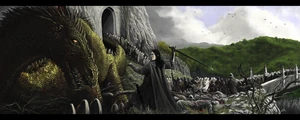Nargothrond (Sindarin IPA: [narˈɡoθrond]) was the Elven stronghold built by Finrod Felagund, delved into the banks of the river Narog in Beleriand during the First Age.
Description
Similar to the structures of many underground Dwarven cities, Nargothrond consisted of many miles of caves and tunnels of various shapes and sizes carved through the rock, which was possibly limestone. There were three Great Halls centered around the other tunnels and caves, where the Lord of the city no doubt sat. The deepest of the caves was the Innermost Chamber where Glaurung later hoarded up the remaining treasures of Nargothrond and sat upon them until he left. Lúthien lived in a southwestern cave chamber during her stay there. The realms armouries were in several chambers south of the Great Halls. The main entrance through the Doors of Felagund to Nargothrond facing river Narog one came into a large chamber, which was about five-hundred feet from the Great Halls of Felagund.[3]
History
Years of Peace
Inspired by Menegroth in Doriath, and seeking a hidden place from which to be safe from the forces of Morgoth, Finrod established it in the early years following the return of the Ñoldor to Middle-earth, in the Caverns of Narog beneath the forested hills of Taur-en-Faroth on the western bank of Narog. He was aided by the Dwarves of Nogrod who also made for him the Nauglamír, the Necklace of the Dwarves.
However, Finrod was not the first to delve in those caves: it had first been inhabited by the Petty-dwarves, who called it Nulukkizdîn (Khuzdul IPA: [nulukːizdiːn]) before they were driven out. Originally, a narrow path along the banks of the river could only reach it, but later a bridge was built across Narog.
Finrod ruled Nargothrond until he joined Beren in his Quest for the Silmaril, being succeeded by his nephew Orodreth. However, the Sons of Fëanor, Celegorm and Curufin lived in Nargothrond at this time and carried a great influence with its people, sowing fear and distrust of outsiders. After Finrod's death was reported they were exiled in disgrace.
Fall of Nargothrond

Túrin and Glaurung (image by woutart).[4]
Since its foundation by Finrod, the Elves of Nargothrond had pursued a secretive war against Morgoth, hunting his forces by stealth and ambush rather than going to open war. When Túrin was led there by Gwindor, however, he grew high in the esteem of Orodreth, Lord of Nargothrond, and counseled a different strategy.
Túrin Turambar became one of the chief captains, persuading the people to abandon their long standing policy and instead fight openly against Morgoth.
Túrin persuaded Orodreth to build the Bridge of Nargothrond to allow speedy passage of forces into the field. Orodreth built the bridge from his doors across the Narog, and went to open war with Morgoth. In centuries of searching, Morgoth had been unable to find the fortress of Nargothrond, but now not only was its location revealed, but the new bridge removed the defence of the River Narog. Glaurung the dragon was sent out from Angband with an army of Orcs to capture the city. After the defeat of the army of Nargothrond at the field of Tumhalad in FA 495, Glaurung and his army of Orcs came south, crossed the bridge, and sacked the city killing or selling the survivors into slavery.
Glaurung remained there until FA 499 when he went northeast to Brethil, to assail Túrin Turambar who eventually slew him. Though the realm was no more, Mîm, the Petty-dwarf took up residence in caves claiming it and its treasures as his own in payment for the sufferings of his people, until Húrin came and slew him for his betrayal of his son. The treasure, including the Nauglamír, was then brought to the Elven Kingdom of Doriath and given to King Thingol.[5] Afterwards, the caves were destroyed during the War of Wrath, along with most of northwestern Middle-earth.
Translations around the World
| Foreign Language | Translated name |
|---|---|
| Amharic | ኛርጎጥሮንድ |
| Arabic | نارعوتهروند |
| Armenian | Նարգոտհրոնդ |
| Bengali | ণার্গথ্রন্দ |
| Bulgarian | Нарготронд |
| Catalan | Nargòthrond |
| Chinese (Hong Kong) | 納國斯隆德 |
| Georgian | ნარგოთჰრონდ |
| Greek | Ναργοθρονδ |
| Gujarati | ણર્ગોથ્રોન્દ |
| Hebrew | נארגות'רונד |
| Hindi | नार्गोथ्रोन्द |
| Japanese | ナルゴスロンド |
| Kazakh | Нарготһронд |
| Kurdish | نارگۆتهرۆند |
| Kyrgyz | Нарготhронд |
| Macedonian | Нарготхронд |
| Mongolian | Нарготhронд |
| Nepali | णर्गोथ्रोन्द |
| Pashto | نارګوتهروند |
| Persian | نارگوتروند |
| Russian | Нарготронд |
| Sanskrit | णर्गोथ्रोन्द् |
| Serbian | Нарготхронд (Cyrillic) Nargothrond (Latinised) |
| Sinhala | ණර්ගොථ්රොඳ් |
| Tajik | Нарготҳронд |
| Tamil | ணர்கொத்ஹ்ரொந்த் |
| Telugu | ణర్గొథ్రొన్ద |
| Tigrinya | ኛርጎጥሮንድ |
| Urdu | نآرگوترونڈ |
| Uyghur | نارگوتھروند |
| Uzbek | Нарготҳронд (Cyrillic) Nargothrond (Latinised) |
| Yiddish | נאַרגאָטהראָנד |
| Dwarven realms of Middle-earth throughout the Ages | |
|---|---|
| Years of the Trees and First Age: | Amon Rûdh | Belegost | Khazad-dûm | Mount Gundabad | Nogrod | Narukuthûn | Blue Mountains |
| Second Age: | Khazad-dûm | Belegost | Nogrod | Mount Gundabad | Blue Mountains | Iron Hills |
| Third Age: | Grey Mountains | Iron Hills | Khazad-dûm | Lonely Mountain | Blue Mountains | Dunland |
| Fourth Age: | Glittering Caves | Khazad-dûm | Lonely Mountain | Blue Mountains | Iron Hills |
References
- ↑ 1.0 1.1 The History of Middle-earth, Vol. 11: The War of the Jewels, Part One. The Grey Annals
- ↑ The Atlas of Middle-earth, Thematic Maps, "Languages"
- ↑ The Atlas of Middle-earth, The First Age, The Elder Days, "Nargothrond"
- ↑ http://poover.deviantart.com/art/The-Fall-Of-Nargothrond-138581489
- ↑ The Silmarillion, Quenta Silmarillion, Chapter XXI: "Of Túrin Turambar"
Template:Space
